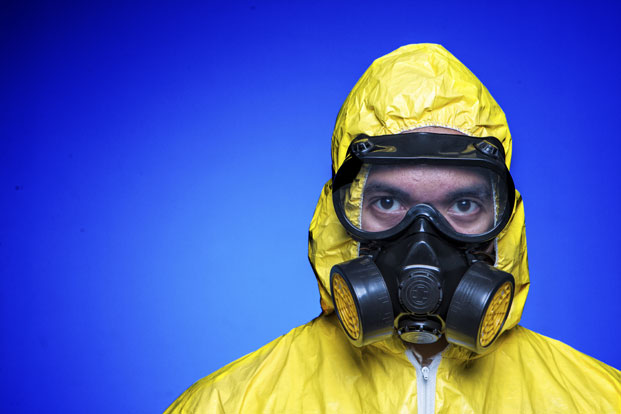The symptoms are terrifying, both because in late stages they’re so severe and because in early stages they’re so vague: fever, joint and muscle aches, chills, flu-like symptoms. And that’s just the beginning; the end is far more sinister.
The Ebola virus disease (EVD) is an acute, deadly illness with a high mortality rate: up to 90 percent in past outbreaks, but with an average mortality rate of 50 percent. This highly contagious killer first popped up in 1976 with two simultaneous outbreaks: one in Nzara, Sudan, and one in Yambuku, Democratic Republic of Congo. The second outbreak occurred in a village near the Ebola River, where the disease gets its name.
It is thought that fruit bats are the natural host for the Ebola virus. However, the virus is spread to the human population through contact with the blood, secretions, organs or bodily fluids of a number of infected animals, ranging from the fruit bats themselves to chimpanzees, gorillas, monkeys, forest antelope and porcupines.
The disease is then spread through the population through contact with infected individuals and/or their body fluids. The first virus outbreaks occurred in remote villages in Central Africa, which limited the spread of the virus beyond the villages.
The current outbreak, which was first identified in March 2014, is the most widespread and complex outbreak since its discovery. There have been more deaths and diagnosed cases during this outbreak than there have been during all previous outbreaks combined, and it has spread between countries on a massive scale, finally breaching the U.S> borders in late 2014.
Now that Ebola has traveled into densely populated countries with mass transit and ready international air travel, would you know how to spot the Ebola virus, either in yourself or in a fellow traveler?
Spot the Signs
Early signs and symptoms of Ebola begin within 5 to 10 days of infection, but may have an onset as late as 21 days after exposure, and are so vague that they may not be immediately identified as the virus. Among them, per the World Health Organization (WHO), patients experience:
Fever
Severe headache
Joint and muscle aches
Chills
Weakness
Over time, symptoms become increasingly severe and may include:
Nausea and vomiting
Diarrhea (may be bloody)
Red eyes
Raised rash
Chest pain and cough
Stomach pain
Severe weight loss
Bleeding, usually from the eyes, and bruising (people near death may bleed from other orifices, such as ears, nose and rectum)
Internal bleeding
When To Seek Medical Attention
If you or a loved one has been in an area known to have Ebola virus, or if you have come in contact with a person known or suspected to have Ebola, and you’ve begun showing symptoms, you have to approach treatment with a two-fold approach: seek medical attention as quickly as possible, but do so in a way that minimizes risk to your family, loved ones, or the community at large.
As counter-intuitive as that sounds, do not get in your car and drive straight for the emergency room. First, call your doctor and local ER to let them know that you suspect that you’ve contracted the virus, and follow their instructions for how to get treatment. Once you’ve done that, follow up with a call to the local health department and the CDC, who can mobilize to give you the best odds for survival.
According to the CDC, If you have not begun showing symptoms but have recently traveled to an area where there have been confirmed cases, shared a plane with an infected person, or have another reason to suspect that you’ve been exposed, take your temperature and do a self-inventory.
People who have been in any of these situations should monitor themselves for a minimum of 10 days. You’ll want to take your temperature several times a day to make sure you don’t get a fever above 100.4 – and if this happens, or if you start to develop the flu-like symptoms outlined above, you’ll want to contact your doctor immediately.
Let your doctor or emergency medical care provider know that you have reason to suspect that your flu-like symptoms may be something more, and provide as much detail as possible to the health unit so that you can assist with tracking potential transmissions (e.g., if you’ve traveled by plane after the onset of symptoms, provide a flight number and date and time). Once you’ve begun to show symptoms, you are contagious, and you should take appropriate steps to limit your risk of spreading the disease to others, such as avoiding contact with children or other family members.
Catch Early For Best Odds
Early diagnosis and supportive care, including rehydration through oral and IV fluids and symptomatic treatment improves the chance of survival. While there are no licensed treatments currently available, several therapies are under development, including blood products, immune and drug therapies, and there are two potential candidates for an Ebola vaccine.
Those who survive the disease need to take appropriate steps to avoid passing the virus on to relatives and loved ones with whom they come into contact. Survivors, despite having gotten past the active stages of the disease, are still contagious for as long as their blood and bodily fluids, including semen and breast milk, contain the virus. For example, men who have recovered can still spread the virus through their semen for up to 7 weeks after their symptoms have passed.
Limiting Its Reach
Community engagement is essential to limiting outbreaks, as is a civic emergency plan and strong hospital safety policies. Policies that include interventions, surveillance and contact tracing, and safe burials will limit the spread of an outbreak from the top down, but raising public awareness of the risk factors and symptoms of Ebola and necessary protective measures is key to reducing transmission, but in the US and in the countries where outbreaks happen with greater frequency.

Leave a Reply